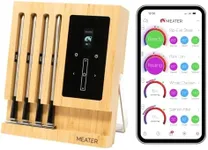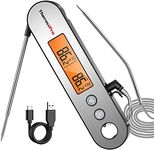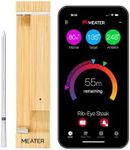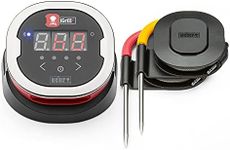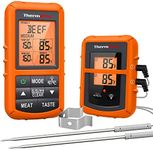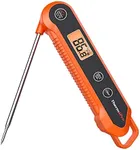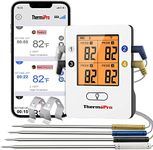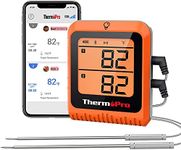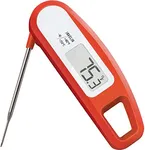Buying Guide for the Best Meat Thermometers
Choosing the right meat thermometer can make a big difference in your cooking, helping you achieve perfectly cooked meat every time. The main goal is to find a thermometer that is accurate, easy to use, and suitable for the types of cooking you do most often. By understanding the key features and how they relate to your needs, you can confidently select a thermometer that will serve you well in the kitchen or at the grill.Type (Instant-Read vs. Leave-In)The type of meat thermometer refers to how and when you use it during cooking. Instant-read thermometers give you a quick temperature reading when you insert them into the meat, making them great for checking doneness at the end of cooking. Leave-in thermometers, on the other hand, stay in the meat while it cooks, allowing you to monitor the temperature throughout the process. If you often grill or roast large cuts, a leave-in thermometer can be very helpful. For quick checks or thinner cuts, an instant-read model is usually more convenient.
Temperature RangeThe temperature range tells you the minimum and maximum temperatures the thermometer can measure. This is important because different types of meat and cooking methods require different temperature ranges. Most home cooks will be fine with a thermometer that covers 32°F to 400°F (0°C to 200°C), but if you plan to use it for candy making or deep frying, you might need a higher range. Make sure the thermometer you choose covers the temperatures you expect to use most often.
AccuracyAccuracy is how close the thermometer's reading is to the actual temperature. This is crucial for food safety and for achieving the desired doneness. Most good thermometers are accurate within 1-2 degrees. If you want precise results, especially for rare or medium-rare meats, look for a thermometer with a high accuracy rating. For general home use, a small margin of error is usually acceptable, but more serious cooks may want the most accurate option.
Response TimeResponse time is how quickly the thermometer gives you a reading after you insert it into the meat. Faster response times are more convenient, especially when grilling or cooking multiple items. Instant-read thermometers typically provide a reading in 2-5 seconds, while some older or less advanced models may take longer. If you value speed and efficiency, look for a thermometer with a quick response time.
Display and ReadabilityThe display is how you see the temperature reading. A clear, easy-to-read display is important, especially in low light or when you're in a hurry. Some thermometers have backlit screens or large numbers for better visibility. If you often cook outdoors or in dim kitchens, consider a model with a bright, readable display. For those with vision challenges, larger displays can be especially helpful.
Probe Length and MaterialThe probe is the part of the thermometer that goes into the meat. Longer probes are useful for larger cuts or for reaching the center of roasts, while shorter probes are fine for thinner meats. Stainless steel is the most common material, as it is durable and easy to clean. If you cook a variety of meats, choose a probe length that matches your typical cuts, and always look for food-safe, rust-resistant materials.
Additional Features (Timers, Alarms, Connectivity)Some thermometers come with extra features like built-in timers, alarms that alert you when your meat reaches a set temperature, or even wireless connectivity to your phone. These features can add convenience, especially if you multitask while cooking. If you like to monitor your cooking from a distance or want reminders, consider a thermometer with these added functions. If you prefer simplicity, a basic model may be all you need.
